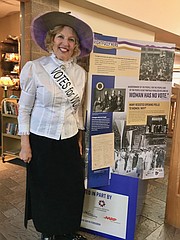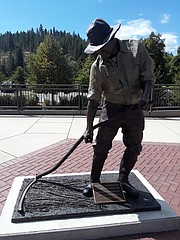Sculptor feels the weight they bore
His tribute, ‘The Suffragist,’ unveiled Aug. 18
For Terry Lee, the opportunity to commemorate the centennial of one of America’s landmark moments in voting rights was never on his initial radar.
“I was just going to work on the miner,” Lee said. “I was working on that for my history walk project when I was asked, ‘Where’s the woman?’”
Lee’s miner project was intended to be installed alongside his other sculptures of workers reflecting the heart of North Idaho’s tireless working spirit. But the question from some of his supporters — “Where’s the woman?” — came as local historians and women’s rights advocates noted Aug. 18, 2020, the 100th anniversary of the Woman’s Suffrage movement.
“My idea was for a World War II nurse from Farragut,” he recalled. “You know, we had nurses serving just up the road from us. But then someone said, ‘Why don’t you (sculpt) a suffragist?’ So I started looking into it.”
That beginning research opened up an entire slice of American history Lee admitted he knew little about before taking on the endeavor. Now, the artist who works out of his Hayden studio will unveil his newest piece at History Walk on Aug. 18.
“The Suffrage movement was a difficult time,” he said. “Once I started reading about it more and understanding it better, I looked at numerous photographs of 1920. And Lisa was instrumental in educating me about the movement.”
Lisa Nunlist is co-president of the Coeur d’Alene branch of the American Association of University Women, a group founded in 1881 to fight to get women and girls permitted to go to college. She, along with a bevy of supporters known as the Friends Of Terry, have championed awareness and fundraising efforts for the fight before and after Aug. 18, 1920, the day the 19th Amendment was ratified into the United States Constitution, empowering women with the right to vote. Nunlist said her enthusiasm for the project was rewarded with Lee’s willingness to learn — not only about the moment the right to vote was ratified but the moments that came before.
“There’s a date on a calendar, but that date in history doesn’t reflect the conversations with the grandmother about how she was widowed after her husband died in a mine accident, and the very next day, another miner was there to take her place, while she had no widow’s benefits,” she said. “It doesn’t reflect how women generally out West have stood side-by-side with the men. If there’s a farmer standing there, his wife was standing behind him. If a miner is working, the women were part of the support structure. It’s when the women came in that the communities here saw any kind of stability.”
Lee’s statues of a miner, farmer and worker on the history walk were critical to Idaho’s history, Nunlist said, but the role of women necessitates a statue, as well, at the very minimum.
“Women came out West to seek a new opportunity,” Nunlist said, “and what did that take? Risk. Risk and bravery … There’s a different mindset out West. There’s more of a grit. We’re made of strong stuff, and the women who stepped out — the ones who took a chance — stood side-by-side with the men, building this country.”
Lee said discovering that history helped make him a more informed artist, something that empowered him to move forward with the project. Once he felt ready, he studied photographs of American suffragists and crafted his design for the statue-to-be.
“Then I hired a model, we went to a costume shop and picked out a great costume from the 1920s,” he said. “I took detailed measurements with the model standing still in the same position, holding a sign.”
Lee then constructed a maquette, an 18-inch replica of his vision, something tangible he could submit to the Coeur d’Alene Arts Commission for approval. Funded exclusively with private donations — like each of his other statues on History Walk — Lee began his seven-month journey to produce the full-sized and final version of “The Suffragist,” which will be unveiled Aug. 18 at a noon ceremony on Front Street. When asked how the statue helped him grow as an artist, he said each project he’s worked on has taught him something new about himself.
“When I’m working on a project, sometimes I’m so close that I don’t see it,” Lee said. “I have that difficultly when I’m painting sometimes, too. I’m constantly growing, constantly trying to figure out texture … You always want to learn.”
Lee, who practiced his craft for nine years with renowned nature artist and Harrison resident George Carlson, said persistence helps him endure.
“I was fortunate to sit at the feet of one of the great ones,” he said of Carlson. “I’m still embarrassed I don’t meet his expectations, but I try. I really try.”





